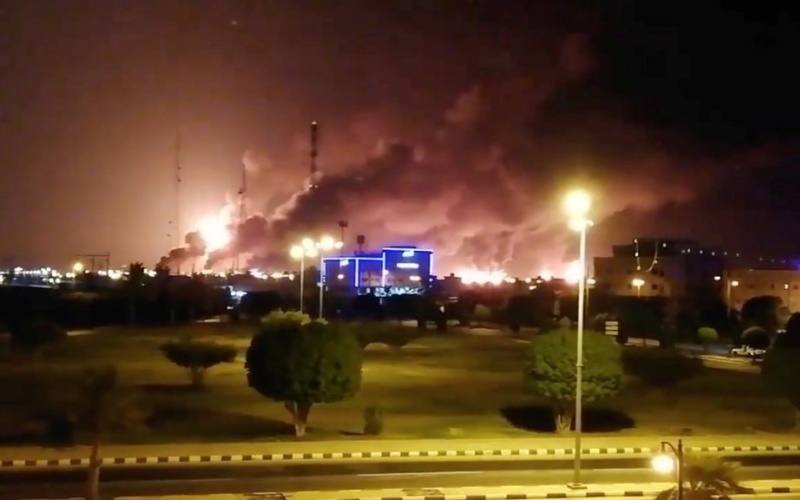Fires at an Aramco oil facility in Saudi Arabia after drone strikes, September 14, 2019
UPDATE, 1115 GMT:
Iran has officially rejected the claim that it is responsible for the drone attack on the Saudi oil facilities.
Foreign Ministry Spokesman Abbas Mousavi said, “Such fruitless and blind accusations and remarks are incomprehensible and meaningless.”
He asserted that the US tactics of “maximum pressure” on Iran were leading to “maximum lies for their failures”.
Foreign Minister Mohammad Javad Zarif put out a less formal but sharper denial on Twitter:
Having failed at "max pressure", @SecPompeo's turning to "max deceit"
US & its clients are stuck in Yemen because of illusion that weapon superiority will lead to military victory.
Blaming Iran won't end disaster. Accepting our April '15 proposal to end war & begin talks may.
— Javad Zarif (@JZarif) September 15, 2019
Gen. Amir Ali Hajizadeh, the head of the Revolutionary Guards’ air force, announced that Iran is ready for “full-fledged” war:
In addition to US bases in the region, we have all their vessels, including aircraft carriers and warships, under fire of our missiles to a radius of 2,000 km, and are constantly monitoring them.
They thought that they could get out of our range of fire if they stand 400 km away. However, no matter where they are, if a conflict is ignited, their warships will be first to be targeted by our fire.
ORIGINAL ENTRY: US Secretary of State Mike Pompeo has blamed Iran for a drone attack on two major Saudi oil installations, more than halving the country’s oil production.
Yemen’s Houthi insurgency, which controls much of the country and has battled a Saudi-led coalition for 4 1/2 years, claimed the strikes.
Houthi spokesman Brig. Gen. Yahya Sare’e, said forces had “carried out a massive offensive operation of 10 drones targeting Abqaiq and Khurais refineries”.
But Pompeo declared that Iran was behind the “unprecedented attack on the world’s energy supply”. He went further by saying that there was “no evidence the attacks came from Yemen”, 500 miles from the Saudi installations.
We call on all nations to publicly and unequivocally condemn Iran’s attacks. The United States will work with our partners and allies to ensure that energy markets remain well supplied and Iran is held accountable for its aggression
— Secretary Pompeo (@SecPompeo) September 14, 2019
The White House said Donald Trump called Saudi Crown Prince Mohammed bin Salman and offered support for “Saudi Arabia’s self defense”. The statement said the US “remains committed to ensuring global oil markets are stable and well supplied”.
Saudi facilities have been targeted by drones this year. In May, an attack damaged pumping stations, with the Houthis claiming responsibility. Saudi officials said oil production continued “normally without interruption”.
The two oil facilities struck on Saturday can process 8.45 million barrels per day. State-owned Aramco said production of 5.7 million bpd was suspended.
But specialists on the Saudi oil industry said they had been told that the lasting impact would not be severe, with perhaps only a few days’ outage.
A “person familiar with the matter” said most output will be restored within 48 hours.
Aramco can supply customers for several weeks through a global storage network, with millions of barrels in tanks in the kingdom and in three strategic locations abroad: Rotterdam in the Netherlands, Okinawa in Japan, and Sidi Kerir on the Mediterranean coast of Egypt.
Iranian Responsibility?
UN investigators says the Houthis have advanced drones with a range of up to 930 miles. However, analysts say the drones could also be launched from another country such as Iraq.
Iran has provided political support for the Houthis, who took over the Yemeni capital Sana’a in early 2015, just before Saudi Arabia, the UAE, and allies began aerial attacks. The US says the Islamic Republic is also providing arms, including drone and missile technology, and training to the Houthis, a claim denied by Tehran.
Iran State outlet Press TV did not respond directly to the allegations. Instead, it headlined a declaration by Sen. Lindsey Graham, a friend of Trump’s:
It is now time for the US to put on the table an attack on Iranian oil refineries if they continue their provocations or increase nuclear enrichment.
Iran will not stop their misbehavior until the consequences become more real, like attacking their refineries, which will break the regime’s back.
But citing “experts”, the website claims that the US would have to ensure global oil supplies by resume sanctions waivers for Iran’s top customers.
The Trump Administration granted six-month waivers on Tehran’s leading buyers — such as China, Turkey, India, South Korea, and Japan — when comprehensive US sanctions were imposed in Iran in November.
The waivers ended in May. Iran’s official exports are now reportedly between 100,000 and 400,000 barrels per day, compared to 2.5 million bpd in April 2018.
See Iran Daily, September 6: Oil Exports Sink to 160,000 Barrels Per Day — Report


Frankly, we don’t feel too sorry for Saudi Arabia.
The have annihilated Yemen and it’s population with US furnished weapons. The number of lives lost is almost incalculable, and it is the among the poorest nations on earth.
There is nothing left for MBS to bomb !.
And how did this start? lets call you David